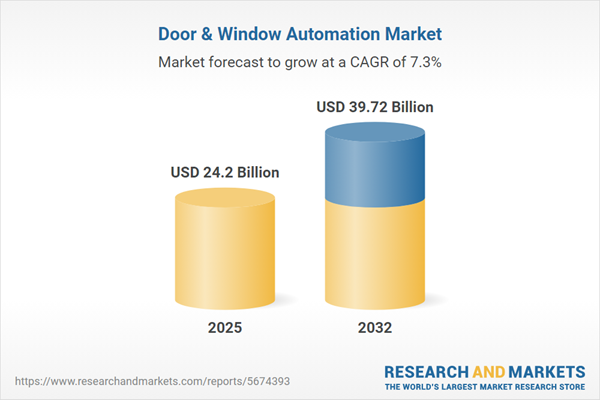Speak directly to the analyst to clarify any post sales queries you may have.
The door and window automation market is rapidly advancing, enabling organizations to streamline facility management with smarter, more secure access solutions. Innovations in automated access support compliance, drive operational efficiency, and enhance oversight across diverse property portfolios.
Market Snapshot: Growth and Outlook for the Door and Window Automation Market
As of 2024, the door and window automation market is valued at USD 22.53 billion, with projections reaching USD 24.20 billion in 2025 and USD 39.72 billion by 2032. This reflects a steady compound annual growth rate of 7.34%. Growth is fueled by increasing infrastructure investments, a rising demand for smart access controls, and ongoing digital transformation initiatives. Organizations across commercial, industrial, institutional, and residential sectors are modernizing to boost resilience and adaptability. Evolving regulatory requirements and the pressing need for flexible management continue to shape and expand industry adoption.
Scope & Segmentation: Door and Window Automation Market Overview
Senior decision-makers and facility leaders rely on automated door and window solutions to improve compliance and operational agility across multisite properties. Market segmentation addresses a variety of technological, operational, and geographic needs, supporting optimal solution matching for unique industry challenges.
- Components: A comprehensive range of actuators—electric, hydraulic, pneumatic—enables precise movement in automation systems. Wired and wireless controllers support centralized operation, while operator mechanisms are available for folding, sliding, and swinging applications. Integrated sensors, such as motion, proximity, and safety types, enhance both responsiveness and security.
- Operation Types: Solutions are designed for folding, swinging, sliding, and overhead access requirements. These systems serve high-traffic commercial facilities, sensitive healthcare environments, educational settings, and residential properties where dependable access control is essential.
- Technologies: Incorporating IoT integration, door and window automation platforms provide real-time monitoring and diagnostic capabilities. Environmental sensors further support predictive maintenance schedules, and remote management platforms facilitate timely incident response with ongoing oversight.
- Power Sources: Automation primarily relies on electric power, with battery or hydraulic backups ensuring uninterrupted facility operations and risk reduction during power disruptions.
- End Users: The market serves commercial enterprises, industrial complexes, healthcare organizations, multi-residential buildings, and educational institutions. Each sector values efficiency, safety, and adherence to compliance standards.
- Sales Channels: Procurement is enabled through diverse avenues: direct purchasing, distributor networks, e-commerce platforms, and manufacturer portals, catering to strategic sourcing requirements and procurement preferences.
- Regions: Adoption spans the Americas, Europe, Asia Pacific, the Middle East, and Africa. Each region’s uptake is influenced by regulatory frameworks, infrastructure development, and regional digital transformation strategies.
Key Takeaways for Senior Leaders
- Centralized integration across automated doors and windows streamlines property supervision, supporting management teams in maximizing operational oversight and delivering consistent occupant experience.
- Modular automation architectures allow rapid response to regulatory changes, helping organizations maintain agility and operational continuity in dynamic compliance environments.
- Advanced diagnostics and predictive analytics enable proactive maintenance planning, increase resource efficiency, and extend value across both newly constructed and legacy facilities.
- Embedded safety, access, and operational efficiency features bolster sustainability initiatives and facilitate implementation in both new projects and retrofits.
- Strategic supply chain diversification and flexible sourcing models strengthen organizational resilience and business continuity amid shifting global trade dynamics.
Tariff Impact: Policy and Sourcing Implications
Current U.S. tariffs on key automation components are prompting a reassessment of sourcing strategies across the industry. Organizations are increasingly evaluating domestic suppliers and broadening regional or international partnerships. This realignment aims to reinforce supply chain resilience while minimizing risks associated with evolving trade regulations and policy adjustments.
Methodology & Data Sources
The findings in this report draw directly from interviews with industry executives, technical experts, and distribution partners. Additional technical documentation and compliance assessments lend further confidence to the market recommendations and strategic guidance included here.
Door and Window Automation Market: Why This Report Matters
- Prepares executive teams to anticipate regulatory changes and respond effectively to evolving market dynamics.
- Offers clear recommendations for procurement, technology selection, and risk management, supporting improved compliance and operational approaches.
- Facilitates alignment between digital transformation, sustainability goals, and future sector demands.
Conclusion
Informed decision-making backed by robust, data-driven insights helps organizations advance their automation initiatives, maintain compliance, and adapt confidently to the evolving landscape of property operations.
Additional Product Information:
- Purchase of this report includes 1 year online access with quarterly updates.
- This report can be updated on request. Please contact our Customer Experience team using the Ask a Question widget on our website.
Table of Contents
3. Executive Summary
4. Market Overview
7. Cumulative Impact of Artificial Intelligence 2025
Companies Mentioned
The companies profiled in this Door & Window Automation market report include:- ASSA ABLOY AB
- dormakaba Group
- Allegion PLC
- Stanley Black & Decker, Inc.
- Somfy SAS
- Nice S.p.A.
- The Chamberlain Group LLC
- Hörmann KG Verkaufsgesellschaft
- GEZE GmbH
- Nabtesco Corporation
Table Information
| Report Attribute | Details |
|---|---|
| No. of Pages | 192 |
| Published | November 2025 |
| Forecast Period | 2025 - 2032 |
| Estimated Market Value ( USD | $ 24.2 Billion |
| Forecasted Market Value ( USD | $ 39.72 Billion |
| Compound Annual Growth Rate | 7.3% |
| Regions Covered | Global |
| No. of Companies Mentioned | 11 |









